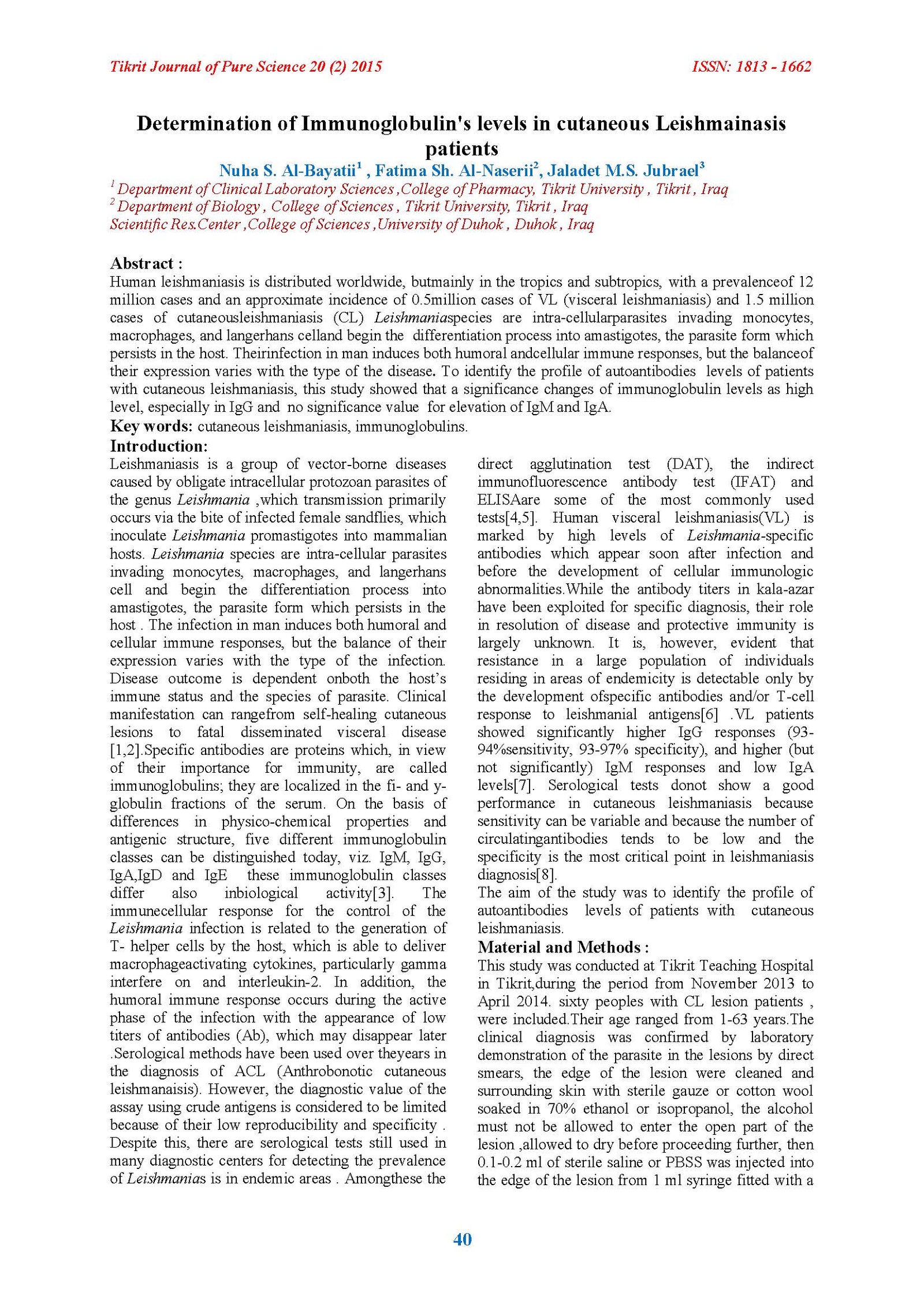Determination of Immunoglobulin's levels in cutaneous Leishmainasis patients
Main Article Content
Abstract
Human leishmaniasis is distributed worldwide, butmainly in the tropics and subtropics, with a prevalenceof 12 million cases and an approximate incidence of 0.5million cases of VL (visceral leishmaniasis) and 1.5 million cases of cutaneousleishmaniasis (CL) Leishmaniaspecies are intra‐cellularparasites invading monocytes, macrophages, and langerhans celland begin the differentiation process into amastigotes, the parasite form which persists in the host. Theirinfection in man induces both humoral andcellular immune responses, but the balanceof their expression varies with the type of the disease. To identify the profile of autoantibodies levels of patients with cutaneous leishmaniasis, this study showed that a significance changes of immunoglobulin levels as high level, especially in IgG and no significance value for elevation of IgM and IgA.
Article Details

This work is licensed under a Creative Commons Attribution 4.0 International License.
Tikrit Journal of Pure Science is licensed under the Creative Commons Attribution 4.0 International License, which allows users to copy, create extracts, abstracts, and new works from the article, alter and revise the article, and make commercial use of the article (including reuse and/or resale of the article by commercial entities), provided the user gives appropriate credit (with a link to the formal publication through the relevant DOI), provides a link to the license, indicates if changes were made, and the licensor is not represented as endorsing the use made of the work. The authors hold the copyright for their published work on the Tikrit J. Pure Sci. website, while Tikrit J. Pure Sci. is responsible for appreciate citation of their work, which is released under CC-BY-4.0, enabling the unrestricted use, distribution, and reproduction of an article in any medium, provided that the original work is properly cited.
References
[1] Paola B. (2010).Leishmaniasis: immunologic indicators of clinical progression and mechanisms of immune modulation .Iowa State UniversityGraduate Theses and Dissertations .
[2] Al-Aubaidi, I.K. (2011) Serum Cytokine Production in Patients with Cutaneous Leishmaniasis Before and After Treatment. IRAQI J MED SCI, 9(1):55-60.
[3] Stoop, J.W. Zegers, B.J. Sander, P.C. Ballieux, R.E. (1969). Serum immunoglobulin levels in healthy children and adults. Clin. exp. Immunol. 4, 101-112.
[4] Añez, N. Rojas, A. & Crisante, G. (2007). Evaluation of conventional serological tests for the diagnosis of American cutaneous leishmaniasis Boletin de malariologia y saludambiental, XL ( 1):55-62.
[5] Allain, D.S. & Kagan, I. G. (1975). A directagglutination test for leishmaniasis. Am. J. Trop. Med. Hyg. 24: 232-236
[6] Anam, K. Afrin, F. Banerjee, D. Pramanik. N. Guha, S. Goswami, R. Saha, S. Ali. N. (1999). Differential Decline in Leishmania Membrane Antigen-SpecificImmunoglobulin G (IgG), IgM, IgE, and IgG Subclass Antibodiesin Indian Kala-Azar Patients after Chemotherapy. Infection and immunity . 67( 12): 6663–6669.
[7] El.assad, A. M. S. younisi, S. A. Siddig, M. Grayson, J. Petersen. E. & Ghalib, H.W. (1994). The significance of blood levels of IgM, IgA, IgG and IgG subclassesin Sudanese visceral leishmaniasis patients.ClinExpImmunol 95:294-299.
[8] Hernández,C and Ramírez, J.D.(2013).Molecular Diagnosis of Vector-Borne Parasitic Diseases. Air Water Borne Diseases 2:1.
[9]- Evans, D. (1989). Handbook on isolation, characterization, and cryopreservation of Leishmania. Special programme for research and training in tropical Diseases. WHO.
[10] Profetaluz, Z.M., De Silva, A.R., Silva, F.D., Caligiorne, R.B. and Rabello, A. (2009). Lesion aspirate culture for the diagnosis and isolation of Leishmaniaspp. from patients with cutaneous Leishmaniasis. Mem. Inst. Oswaldo Cruz, Rio de Janeiro;104(1):62-66.
[11] www.lifetechnologies.com/...sample.../plasma-and-serum- preparation.html.
[12] http://www.ltaonline.it. IgG RID, IgM RID, IgAR ID .
[13] Jolliff, C.R et al .(1982). Intervals for serum IgG, IgA, IgM, C3, andC4 as determined by rate nephelometry. Clin Chem 28:126–128.
[14] Awasthi, A. Mathur, R.K. & Saha, B. (2004).Immune response to Leishmaniain fection. Indian J Med Res, 119: 238-258.
[15] Nylen, S. & Eidsmo, L. (2012). Tissue damage and immunity in cutaneous leishmaniasis. Parasite Immunology. 34, 551–561.
[16] Henk, D. F. H. Oskam, S.L. (2002). Molecular biological applications in the diagnosisand control of leishmaniasis and parasite identification. Tropical Medicine and International Health . 7 ( 8): 641–651 .
[17] Reithinger, R. and Dujardin, J.C. (2007). Molecular Diagnosis of Leishmaniasis: Current Status and Future Applications. J. Clin. Microbiol. 45 ( 1): 21-25.
